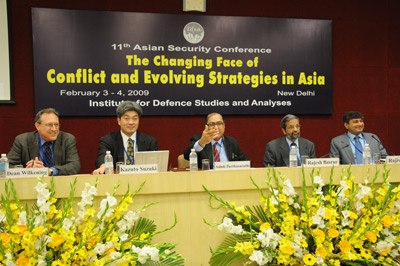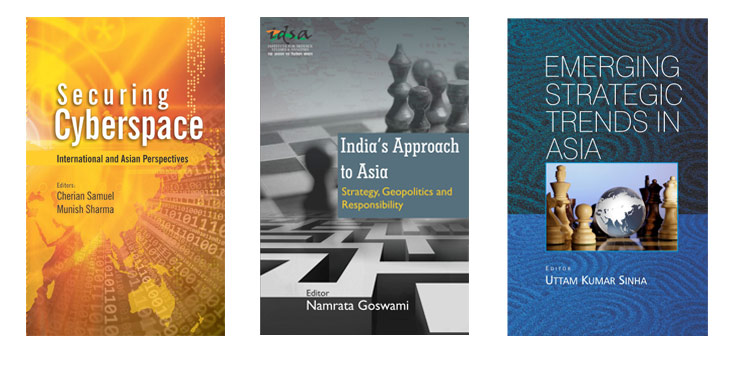You are here
11th Asian Security Conference on "The Changing Face of Conflict and Strategy in Asia"
Rapporteur Report on Session IV
February 04, 2009
Technology and Asian Security
Prepared by Rajiv Nayan and Vinod Kumar

This session comprised of three papers dealing with the technological dynamics of security in the realms of missile defence and space. Dr. Dean Wilkening’s paper titled “The Strategic Impact of BMD in South Asia” comprised of three sections which dealt with the objectives of missile defence, analysis of Indian BMD planning and its impact in Southern Asia. He argued that the basic political objective of an Indian BMD would be to counter the nuclear sabre-rattling by Pakistan and negate its propensity to engage in first strike rhetoric. As for the military objective, it would intend to provide area and point defence to India’s counter-value and counter-force assets through a nationwide coverage.
Dr. Wilkening affirmed the feasibility of a robust but costly nationwide BMD shield, and maintained that in India nationwide missile defences are possible, but expensive in light of other priorities, both military and non-military. He also felt that the political distrust, arms race pressures and perhaps even first-strike incentives could make Indian leaders cautious about assuming that the benefits of BMDs would come with substantial political, economic and security costs. He assessed the viability of existing Indian indigenous programmes, which he felt would have limited defensive capability owing to their limited ranges and restricted coverage given by existing radar systems like the Greenpine. Dr. Wilkening also attempted to analyse the Indian BMD planning process through a scenario of potential deployment of US BMD systems like the THAAD and Aegis, which he felt, could give better area defence than the Indian systems.
At the same time, Dr. Wilkening emphasised the huge costs that are involved and the possibility of its ineffectiveness if India embarked on a thin defensive shield. However, he felt an Indian BMD would be key to its nuclear deterrence calculus and it could counter the threat of first use by Pakistan, but at the same time initiate an offence-defence competition that could lead to an arms race, while also increasing the chances of actors adopting the propensity for pre-emptive attacks.
The paper by Dr. Rajesh Basrur titled “Who’s Afraid of Missile Defence?” questioned the prevailing assumptions on the ability of missile defences to strengthen deterrence. As a proponent of existential deterrence, Dr. Basrur felt that imbalances or asymmetric advantages intended to be created by BMDs would not happen as deterrence would continue to operate through the mere presence of nuclear arsenals, irrespective of their size and posture. He felt the requisite level of risk will exist even if a state has a robust missile defence. Hence, the apprehensions on BMDs effects on nuclear deterrence and its propensity for initiating domino effects were misplaced. Rather, he felt existential deterrence would ensure that BMDs do little to alter the equations.
By citing the Cuban missile crisis and the nuclear status of two cold war adversaries in the 1960s he tried to make the point that numbers do not matter for a nuclear deterrence. Arguing that nuclear deterrence survives imbalances, Dr. Basrur asserted that credibility of arsenals is never an issue He saw the actual role of BMD only when deterrence fails. However, he found that the BMD does not close the window of vulnerability as there is no BMD existing in the world that may assure cent percent assurance in a real war situation. Dr Basrur felt that geography, availability of weapons such as bombers and cruise missiles, and uncertainty associated with the BMD in general would continue to make deterrence work. On the whole, Dr. Basrur felt that one should expect neither gain nor loss to accrue from missile defences.
Professor Suzuki, in his paper titled “Is there a Space Race?” primarily debunked the thesis that there is a space race or moon race in Asia. He highlighted the peaceful uses of space and gave a new dimension to approaches towards security with emphasis on human security. While highlighting that space was a key to security strategies in the Cold War period, Prof. Suzuki argued that space should be seen as both an opportunity as well as a threat to regional security. However, he felt vis-a-vis the security angle, emphasis should be placed on unmanned programmes and their propensity to be used for military objectives.
Prof. Suzuki undertook a comprehensive study of space programmes of Japan, China and India, and analysed the catalysts of these programmes. While analysing these programmes, Prof. Suzuki felt there would be an element of competition among some of these programme, but that did not necessarily imply an arms race in outer space. He identified various objectives that propel these programmes but none pointing to an overt intention of militarization or arms race. He reiterated this sentiment on the Moon projects and Anti-Satellite programme, like that of China. Rather, he saw all these initiatives as contributing to regional security. Prof. Suzuki proposed the establishment of an early warning centre to provide imagery to increase transparency of troop mobilization and proliferation monitoring. He admited that intelligence data would be a sensitive element.
Discussing the three papers, Dr. Rajiv Nayan stated that the relationship between technology and security, which was the theme of the session, was well established by these papers. However, he felt that the question of whether technology drives security or vice versa generally remained unanswered. Dr. Nayan felt that Prof. Suzuki could have dealt more on the security implications and intentions of China’s space aspirations. He felt that the assumptions on nuclear parity elucidated by Dr. Basrur were flawed though he agreed with the assertion in the paper that emphasis should be placed on second strike capabilities. He appreciated the technical analyses by Dr. Wilkening, but cautioned that Indian is a new entrant in ballistic missile defence technologies and hence its capabilities should be examined with proper appreciation of its technological capabilities and threats.
The question and answer session saw a variegated mix of questions touching upon issues like linkage of BMD with no-first-use, speed of interceptors, importance of second strike capability and feasibility of layered defences, among others. Dr. G Balachandran countered Dr. Basrur’s contentions by stating that a country with no-first-use having missile defence would add to stability. Dr. Basrur argued that no-first-use is a declaratory posture which could rarely find favour in an actual nuclear conflict situation. Hence, he argued, favouring costly missile defences would be unwise and emphasis should rather be on second strike capabilities, as he felt BMD would be a tough technological grind for India. On the speed of interceptors, Dr. Wilkening said that an interceptor need not have the speed higher than the target missile and something around half to one-third of the target’s speed would be ideal for precision interception. He, however, affirmed that predicting timeframes for credible operationalisation of BMD systems and their capability to deal with countermeasures is not yet possible. In his reply, Prof. Suzuki said that Japan favours cooperation in space programmes, but would not participate in any space-based missile defence ventures.

